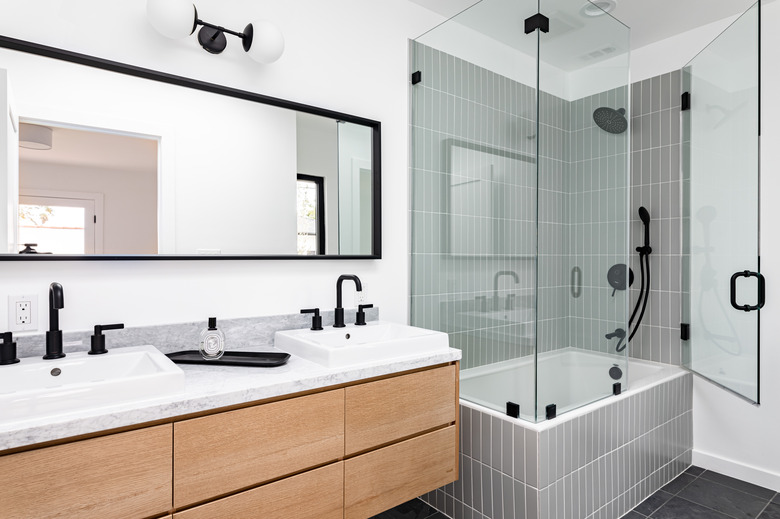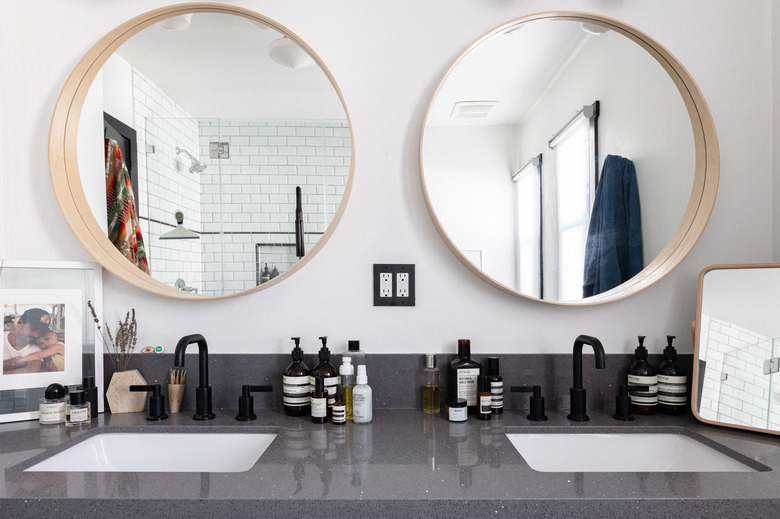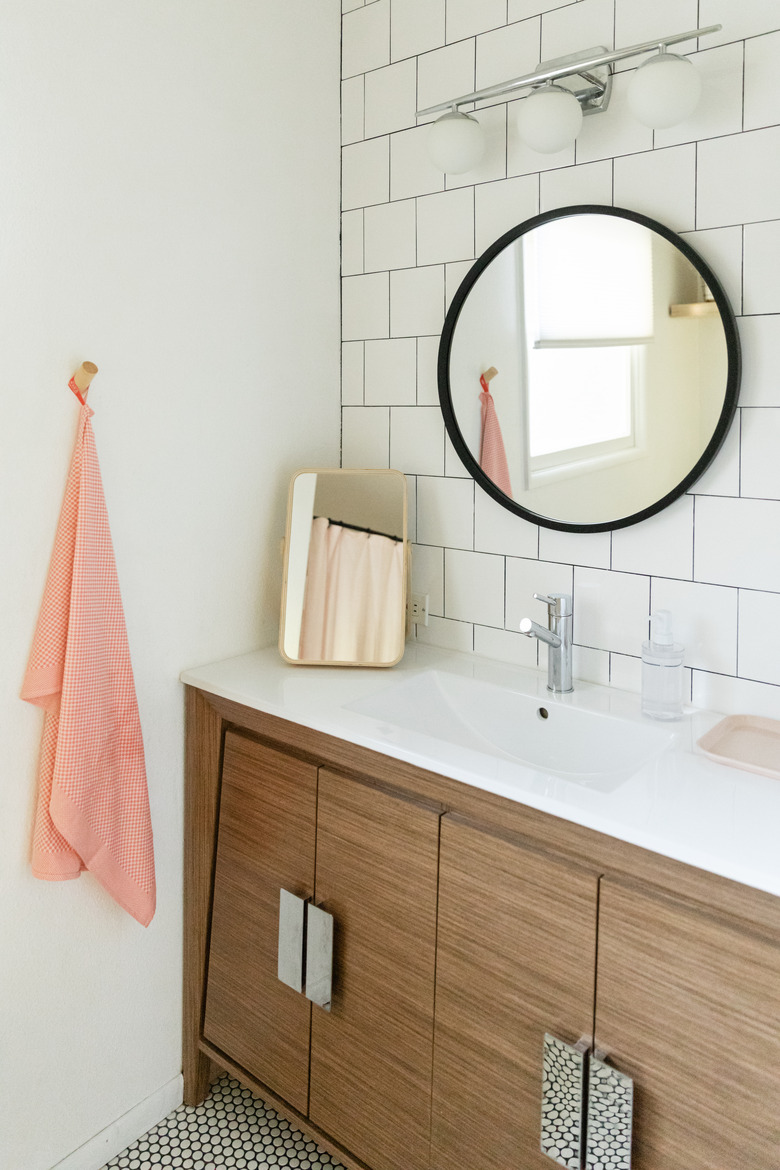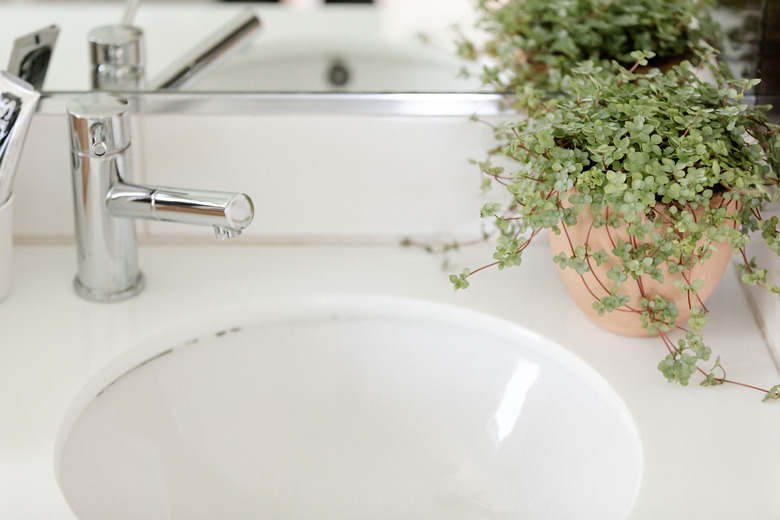Single Vs. Double Bathroom Vanity
In small bathrooms, most people are limited to a single bathroom vanity, but when you have more space, you might want to go with a double vanity. Even if you have the space for a double vanity, they still aren't the right option for every bathroom, and many people find that they prefer a single-sink bathroom vanity or even a bathroom vanity set composed of two single-sink vanities.
Double vs. Single Bathroom Vanity Size
While it's obvious that the main difference between a double or single bathroom vanity is the number of sinks, the other main difference is the size. Double vanities come in a standard size of 60 to 70 inches, though they may be as small as 48 inches. Single vanities are usually somewhere between 24 and 48 inches wide, though they can be as long as 72 inches. This makes sense, as you can't squeeze two sinks into a space so tiny that they cannot be used comfortably at the same time.
If you're working in a powder room or another small guest bathroom, you'll generally need to live with a single sink to ensure your space isn't horribly cramped, even if you have just enough space to install a double vanity. In fact, in particularly small bathrooms and powder rooms where you don't need a lot of storage space for toiletries or other items, you might even forgo using a vanity cabinet altogether and instead go for a stylish wall-mount or pedestal sink. This will create an attractive focal point that makes the room feel a lot larger.
Benefits of Double Vanities
The biggest and most obvious benefit of a double vanity is that it allows two people to use the sinks at once. Whether used in a couple's master bathroom, a Jack-and-Jill bathroom between two bedrooms or a large family bathroom in a one-bathroom home, this can make sharing a bathroom much easier since two people can brush their teeth or wash their hands without getting in each other's way. If you've ever accidentally spit toothpaste on the back of someone's hand while sharing a sink, you know just how nice this benefit is.
Allowing two people to use the sinks at the same time is only one benefit of a double vanity. Others include:
- There is impressive storage space. In fact, due to the extensive
length of the vanity cabinet, you might not need to store anything above the
counter at all. - There is more countertop space, which is useful when it comes to applying
makeup, styling hair or performing other grooming tasks. - Each person can have his own sink and storage area to
organize (or disorganize) as he sees fit. - It can increase your home value since many buyers prefer the
benefits of double vanities.
Cons of Double Vanities
Of course, while there are a lot of reasons a person may choose to install a double vanity, they aren't the right choice for everyone or every home. One of the biggest constraints is size. Even if you can find a double vanity that will fit in your bathroom, it needs to fit comfortably without leaving the toilet area cramped or causing two people who are using the sinks at the same time to bump elbows while brushing their teeth.
Double vanities are also more expensive. While stock single-sink vanities average around $200 to $800, according to CostHelper, a double vanity will cost $900 to $1,500. A single countertop can cost anywhere from $50 to $150, but a double will run $200 to $500. If the vanity sink is sold separate from the countertop, you can expect to add an extra $50 to $250 per sink and $20 to $70 per faucet, with double vanities costing double for sinks and faucets.
Installing a double vanity is more pricey as well. In fact, while HomeAdvisor estimates the cost to install a standard single bath vanity and faucet at only $380, installing a double vanity can cost $1,000 because the large vanity takes extra time when it comes to assembling the cabinet, placing the cabinet, sizing and adhering the top material, securing the vanity to the wall and installing two undermount sinks and two faucets. Plus, you'll have to spend more to have a double-wide mirror or two mirrors and to add a backsplash as long as the vanity top.
There are more expenses if you don't already have two connections in your sink. You'll need to hire a plumber to install extra lines and drain pipes, which can add an extra $1,000 to your home improvement project costs. If your toilet is too close to where you plan to install the sink, you'll need to move the toilet over, and Consumer Reports says this minor remodel can easily cost over $1,000 even if you're only moving it a single foot.
Finally, double the sinks means double the chance of leaks. Remember that instead of two water connections and one drain, you'll have four connections and two drains. This means it's twice as likely that you'll need to call in a plumber to fix a leak or a clogged sink.
Benefits of a Single Bathroom Vanity
Many people love double vanities, but even people who have the space often find they prefer a single bathroom vanity. With the pros and cons of a double vanity in mind, it's worth considering the advantages of working with a single-sink vanity.
-
Not everyone needs two sinks. In fact, many people find that
having just one sink with a long vanity top gives them more countertop space than
they would have in a vanity of the same length with two sinks. Plus, without
the extra set of plumbing connections in the vanity base, you have more storage
space inside the cabinet. A single-sink vanity
cabinet can even house extra drawers that would otherwise run into the pipes. -
It ensures that users have their own private bathroom time.
While some people don't mind sharing the space, others prefer to perform their
morning or evening rituals alone. -
It allows you to spend more on improved home decor. Since a
double vanity can easily cost more than double that of a single-sink vanity,
you can instead put that money toward a James Martin designer vanity, a solid
wood vanity base rather than a cheaper medium-density fiberboardone, an oil-rubbed bronze faucet
instead of a plain chrome one or even a Carrera white marble top that might be
utterly unaffordable with a lengthy double-basin vanity.
Alternatives to a Double Vanity
If you really like the idea of having two sinks but are concerned about the costs or even just want a more modern design option, you might prefer two separate single vanities. You can add extra storage by installing a short cabinet or a few shelves between the two cabinets. This will still require adding the plumbing for two sinks, but the vanities themselves will be less costly to purchase and install.
Alternatively, you might save money on a double vanity cabinet by converting a long dresser into a vanity and using a custom-cut countertop fitted with a ceramic undermount sink on each side. There are many online tutorials to do this conversion, and the result can leave you with a gorgeous and affordable free-standing cabinet.
On the other hand, if you don't have the space for a double vanity or don't want to add extra plumbing, you can also opt for a longer single-basin vanity with a wider sink that might still allow you to share the sink area with your partner without spitting toothpaste on each other's hands.
You can purchase a single or double vanity at the following retailers in a variety of styles and budgets: Joss & Main, Overstock, The Home Deport, Walmart, and Wayfair.
References
- Consumer Reports: How to Cut Bathroom Remodeling Costs
- Hausera: One Sink or Two Sinks in Your Master Bath
- Furniture Guild: Vanity Showdown: Double Sink vs Single Sink
- CostHelper: How Much Do Bathroom Countertops Cost?
- Plumbing Lab: Single Vs. Double Bathroom Sink Vanities For Top Performance
- CostHelper: How Much Does a Bathroom Sink Cost?
- Unique Vanities: The Pros and Cons of a Double Sink Bathroom Vanity
- CostHelper: How Much Does a Bathroom Vanity Cost?
- Consumer Reports: Bathroom Remodeling Guide: Dos and Don'ts
- HomeAdvisor: How Much Does It Cost To Install A Vanity?



